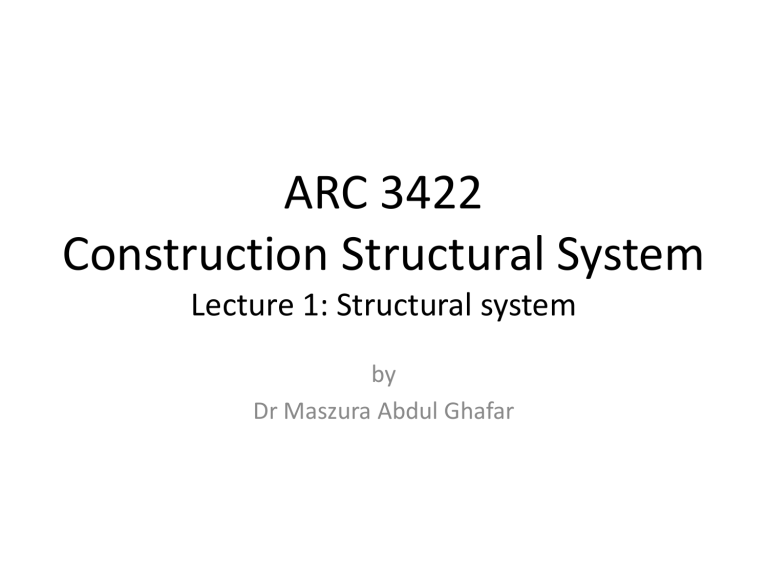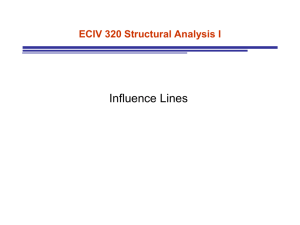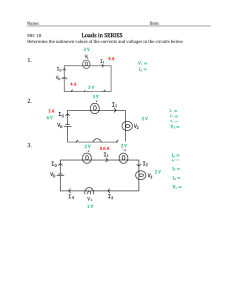ARC 3422- Lecture 1- Intro to structural system-16.2.2021
advertisement

ARC 3422 Construction Structural System Lecture 1: Structural system by Dr Maszura Abdul Ghafar Structure of Course • Attendance minimum 80% before you can sit for exam • Late attendance considered absent • Late submission considered zero or deductible • Marks – Assignment – 60% – Exam – 40% – Attendance and participation – 10% Architects, Engineers and Design • Who did what? • Determining strength, who? Engineer • Determining beauty, who? Architect Architect + engineer = (space) (majestic appearance, sophistication and ingenious architecture) (mechanical) design Stability and strength • What is structure? - satisfying of two basic conditions: stability and strength Stability: various FORCES that act on structure, always in balance to avoid failure Strength: physical make up of structural material that are sufficient to withstand FORCES Stability and strength Lifter supporting Barbell and weights A Failure of Stability A Failure of Strength The potential for structure to enrich architecture • Structure shouldn’t be architecturally mute – Give meaning, richness, metaphor and experience – Eg. Crematorium, Baumschulenweg, Germany Relationships between Architectural and structural form • Consonant forms - structure system co exist with architectural form Tapalpa House Relationships between Architectural and structural form • Contrasting forms - structure system contrast with architectural form, material, geometry, scale & texture Heydar Aliyev Centre , Azerbaijan Structural Design • When designing a structure: 1) You need to know the functionality of the structure- how it influence your building stability, aesthetically and cost 2) Building function/ typologies 3) Affected forces, loads, environments and dimension of structural elements 4) Good negotiation skill with structural engineer Structural Design • Rule of thumb in structural design for architect – For tension forces: you will need high strength steel cables to span in a longer distance such as bridges – For compression forces: you will need arches – For surface resisting tension: you will need 3D membrane structure composting of 2D surfaces resisting tension only – For axial stresses (balance of tension and compression forces): you will need 3D structure composting of 2D curved surfaces. Structural Design • Structure elements: Common elements from which structures are composed Tie Rods • Members that are generally vertical and resist axial compression loads • Subject to both an axial load and a bending moment Structural Design • Structure elements: Common elements from which structures are composed Beam • Beams are usually straight horizontal members used primarily to carry vertical loads • Design to resist bending moment, if they are short and carry large loads, the internal shear force may become quite large Structural Design • Structure elements: Common elements from which structures are composed Column • Structural members subjected to a tensile force • Due to the nature of this load, these members are rather slender, and are often chosen from roads and bars Structural Design • Types of structure: Truss • A truss is an assembly of beams or other elements that creates a rigid and slender element structure • Planar trusses are composition of same plane members that lies 2D flat in the same plane. Joints are usually pin joint type, and members are free to rotate around the pin. • Space trusses are composition planar trusses in 3D. Uses pined joint to allow members to rotate freely about each other. No restraint and no internal bending moment • Due to the arrangement, loads converted to tensile and compression forces to members Structural Design • Types of structure: Cables and Arches Cables • Cable are usually flexible and carry loads in tensions • Commonly used to support bridges. Always in tension, thus will not become unstable and sudden collapse Arch • Arch achieves its strength in compression • Reserve curvature to the cable • Rigid, need secondary loadings (shear and moment) to main its shape. Structural Design • Types of structure: Frames - Often used in buildings Composed together with column with fixed connection Can be 2D or 3D Loading on frame causes bending of its members and if has rigid joint connections (welding and bolting), it is generally “indeterminate”. - Members are subject to axial forces(tensile and compression) Structural Design • Types of structure: Surface structure - Made from thin material. - Usually acts as cables and arches to support tension and compression load, with very little bending Structural Design • Idealized structure Structural Design • Idealized structure Structural Design • Type of support/ support connection – Type of support: roller and frictionless surface, pinned, fixed and hanger – Support can be at the end or at any intermediate points along a member – Type of support affects how reactions will act on members and the kind of movement that the support will restrain. – To facilitate structural analysis, the structure is usually idealized by assuming the act of movement is simplified and pure manner. Structural Design • Type of support/ support connection – Roller and Frictionless-surface support (RFSS) Roller joint • Can be found on one end of bridges to allow thermal expansion and contraction of the span. • RFSS is in the form of rubber bearing that can be used in foundations for limiting seismic (earthquake) movement. • Behave similar like other members n the structure. Structural Design • Type of support/ support connection – Roller and Frictionless-surface support (FSS) • Only support and accept perpendicular forces on a member and away from the surface on which the member rest • RFSS cannot prevent translational and rotation movement in all direction. Structural Design • Type of support/ support connection – Pinned/ Hinged support • Used in bridges and certain type of trusses. Literally are pins usually visible in the bottom chord of inserted Structural Design • Type of support/ support connection – Pinned/ Hinged support • The steel connector attaching web of beam to a girder is called shear connection Shear connection of a steel beam • A pinned support accept forces on a member in any direction. • A pinned support prevents translation movement in any direction but not rotational movement. Structural Design • Type of support/ support connection – Fixed / rigid support • Commonly found in beam to column connections of moment-resisting steel frames, beam cantilever, projection of building etc. • The steel connection attaching the flange/ web of girder is called moment connection Structural Design • Type of support/ support connection – Fixed / rigid support • Can accept a force on a member in any direction and can resist moment and translational moment in rotational directions. • Only have single fixed support but cannot resist deflection. Possible reactions Deformation of a member at a fixed support No Movement Structural Design • Type of support/ support connection – Hanger support • Can be found in suspension bridges, canopies, signs etc • Act only in tension and uses steel cables, rods, and flat bars for supports. Hanger supports on the beam of the bridge Hanger support Hanger supports on a canopy Structural Design • Type of support/ support connection – Hanger support • Accept forces on a member acting away from the member in the direction of the hanger • Cannot prevent any rotational movement and translational movement in any directions. Translational Movement Rotational movement Structure Definition: Loads • Gravity loads Structure Definition: Loads • 1- Lateral loads – Caused by wind and seismic movement – act in horizontally a) Lateral wind load Effect of wind load Lateral load by wind - Depend factors such as velocity, shape and height of building, geometry & proximity of adjacent building - - will cause to sway Structure Definition: Loads Effect of lateral wind load Creates positive pressurepushing inwards buildings exterior surface on windward side Creates negative pressurepushing outwards buildings exterior surface on leeward side Note: for tall & irregular shaped structure use wind tunnel to test Structure Definition: Loads b) Lateral seismic load Lateral load by seismic - Created by random, variable, erratic motion of the ground - Cause to sway Structure Definition: Loads - Wind and seismic load create uplift forces at the base of the structure and overturn it - Communication towers are lightweight therefore susceptible to uplift and overturn Structure Definition: Loads • 2-Dynamic loads - changes rapidly, suddenly, amplified rhythmic movement - Effect of dynamic load → increases its actual static load Constant movement of lift and vehicles are dynamic loads Structure Definition: Loads • 3-Impact loads - Result from sudden collisions or an explosion - Blast resistant design must consider impact force Structure Definition: Loads • 4-Load paths - All loads applied eventually make their way through structure components and down to ground Structure Definition: Loads • 4-Load paths - In framed building loads applied to roofs→ Floors → vertical supports →Structure → foundation →ground Structure Definition: Loads Structure Definition: Stress • 1- Tension - Tendency of a body to be pulled apart. - A pulling effect in a perpendicular direction to its cross section direct tensile stress A rope in tension Structure Definition: Stress • 2- Compression - Tendency of a body to be crushed. - A downward force and the upward resistance to ground Direct compression stress A post in compression Structure Definition: Stress • 3- Shear - Tendency of a body to be sliced. - A pulling force opposite each other in a direction to its cross section A bold under shear Direct shear stress Structure Definition: Stress • 4- Torsion - A type of shear which a body tends to be twisted resulting shear stress A pole sign under torsion A spandrel girder under torsion Structure Definition: Stress • 5- Bending - Tendency of a body to bow therefore creating stress to body - The body compresses at one edge and stretches along the other Horizontal shear parallel to the length of a beam Tension and compression in a beam Vertical shear perpendicular to the length of a beam Structure Definition: Stress • 5- Bending - When load is at the centre of a span, max bending stress occurs Maximum bending stresses at the centre of a span Maximum compression and tensile stresses at the edges of a beam • Thank you



